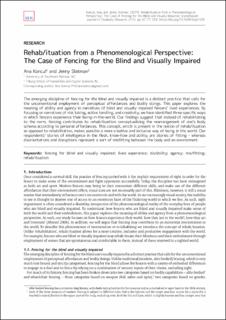| dc.contributor.author | Koncul, Ana | |
| dc.contributor.author | Slatman, Jenny | |
| dc.date.accessioned | 2020-03-16T09:32:00Z | |
| dc.date.available | 2020-03-16T09:32:00Z | |
| dc.date.created | 2019-10-09T15:26:14Z | |
| dc.date.issued | 2019 | |
| dc.identifier.citation | Scandinavian Journal of Disability Research. 2019, 21 (1), 67-77. | en_US |
| dc.identifier.issn | 1501-7419 | |
| dc.identifier.uri | https://hdl.handle.net/11250/2646885 | |
| dc.description | his is an open-access article distributed under the terms of the Creative Commons Attribution 4.0 International License which permits unrestricted use, distribution, and reproduction in any medium, provided the original author and source are credited. | en_US |
| dc.description.abstract | The emerging discipline of fencing for the blind and visually impaired is a distinct practice that calls for the unconventional employment of perceptual affordances and bodily doings. This paper explores the meaning of ability and agency in narratives of blind and visually impaired fencers’ lived experiences. By focusing on narratives of risk taking, active handling, and creativity, we have identified three specific ways in which fencers experience their being-in-the-world. Our findings suggest that instead of rehabilitating to the norm, fencing contributes to rehab/ituation: conceptualising the rearrangement of one’s body schema according to personal affordances. This concept, which is present in the notion of rehab/ituation as opposed to rehabilitation, makes possible a more creative and inclusive way of being in the world. Our respondents’ stories of intelligence in the flesh, know-how and ability, are stories of fitting – whereas disorientations and disruptions represent a sort of misfitting between the body and an environment. | en_US |
| dc.language.iso | eng | en_US |
| dc.rights | Navngivelse 4.0 Internasjonal | * |
| dc.rights.uri | http://creativecommons.org/licenses/by/4.0/deed.no | * |
| dc.title | Rehab/ituation from a phenomenological perspective: The case of fencing for the blind and visually impaired | en_US |
| dc.type | Peer reviewed | en_US |
| dc.type | Journal article | en_US |
| dc.description.version | publishedVersion | en_US |
| dc.rights.holder | © 2019 The Author(s). | en_US |
| dc.source.pagenumber | 67-77 | en_US |
| dc.source.volume | 21 | en_US |
| dc.source.journal | Scandinavian Journal of Disability Research | en_US |
| dc.source.issue | 1 | en_US |
| dc.identifier.doi | 10.16993/sjdr.559 | |
| dc.identifier.cristin | 1735595 | |
| cristin.ispublished | true | |
| cristin.fulltext | original | |
| cristin.qualitycode | 1 | |

